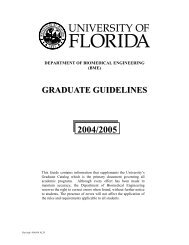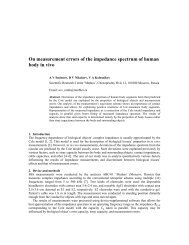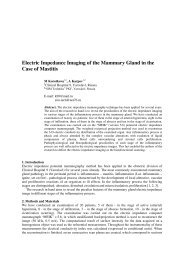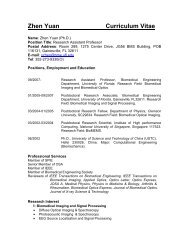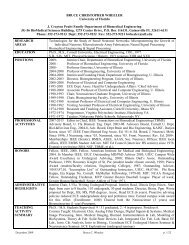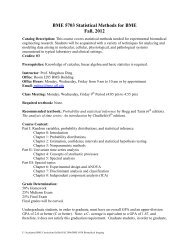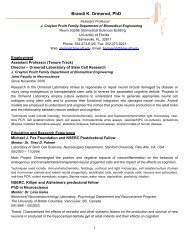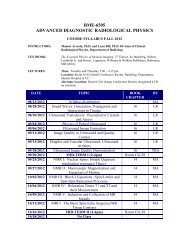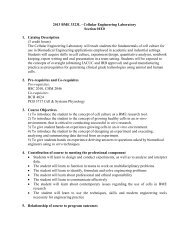Spectrum 2013 - Biomedical Engineering - University of Florida
Spectrum 2013 - Biomedical Engineering - University of Florida
Spectrum 2013 - Biomedical Engineering - University of Florida
You also want an ePaper? Increase the reach of your titles
YUMPU automatically turns print PDFs into web optimized ePapers that Google loves.
Message from the President<br />
Dear UF Health and Medical Physics Alumni and Friends,<br />
Welcome to the second installment <strong>of</strong> <strong>Spectrum</strong>, a newsletter from the Society <strong>of</strong> Health and Medical<br />
Physics Students (SHMPS) at the <strong>University</strong> <strong>of</strong> <strong>Florida</strong>.<br />
Since the inaugural edition <strong>of</strong> <strong>Spectrum</strong>, the Medical Physics program at UF has gone through an exciting<br />
change. We are pleased to announce the merger <strong>of</strong> our program with the J. Crayton Pruitt Family<br />
Department <strong>of</strong> <strong>Biomedical</strong> <strong>Engineering</strong>. As one <strong>of</strong> the few student organizations in this new department,<br />
SHMPS plays a vital role in service and academic outreach programs. Through this newsletter, we hope<br />
to share many <strong>of</strong> the activities <strong>of</strong> SHMPS, as well as the academic and career achievements <strong>of</strong> its current<br />
and past members.<br />
Enjoy!<br />
Message from the Editor<br />
This edition <strong>of</strong> <strong>Spectrum</strong> focuses on building new relationships both internally and externally. Foremost,<br />
we would like to thank our local <strong>Florida</strong> chapters <strong>of</strong> AAPM and HPS for their continued support and opportunities<br />
to highlight our academic talents. We would also like to thank our sponsors: Sun Nuclear<br />
Corporation, Velocity Medical Solutions, Elekta, and Mittauer and Associates. Their contributions allow<br />
students to travel to national conferences and share our research efforts with the medical physics community.<br />
In this issue, we reached out to alumni to tell their stories <strong>of</strong> progression from being a graduate student<br />
to a practicing medical physicist. We find their experiences a testimony to the great education at the<br />
<strong>University</strong> <strong>of</strong> <strong>Florida</strong>.
The Medical Physics Graduate Program at the<br />
<strong>University</strong> <strong>of</strong> <strong>Florida</strong> – Its Past, Present, and<br />
Future<br />
The <strong>University</strong> <strong>of</strong> <strong>Florida</strong>’s Medical Physics Graduate Program has been in continuous existence for 50 years<br />
and has produced hundreds <strong>of</strong> Medical Physics graduates over that time. For the past 30 years, the program<br />
has been a joint effort <strong>of</strong> the multiple departments within the College <strong>of</strong> <strong>Engineering</strong> and College <strong>of</strong> Medicine.<br />
This joint effort continues to evolve to allow the program to capitalize on diverse resources to grow<br />
strong research programs and optimize clinical training and relevance. The program received initial CAMPEP<br />
Accreditation in November <strong>of</strong> 2001 and was reaccredited in 2006 and in 2011. Since 2006, the program<br />
has maintained a relatively constant enrollment <strong>of</strong> approximately 40 graduate students and stable cadre <strong>of</strong><br />
faculty. In May <strong>of</strong> 2011, the program migrated its academic and administrative home to the J. Crayton Pruitt<br />
Family Department <strong>of</strong> <strong>Biomedical</strong> <strong>Engineering</strong> (from the Department <strong>of</strong> Nuclear and Radiological <strong>Engineering</strong>).<br />
Faculty participants and curriculum remain unchanged and the transition has been largely administrative in nature.<br />
A Brief History <strong>of</strong> the Program<br />
In 1961, the Colleges <strong>of</strong> Medicine and <strong>Engineering</strong> jointly sponsored initiation <strong>of</strong> the medical physics graduate program through the Department <strong>of</strong><br />
Radiology and the Department <strong>of</strong> Nuclear <strong>Engineering</strong> Sciences. The graduate program was initially established as part <strong>of</strong> a U.S. Public Health Service<br />
funded program to train radiation health scientists. In 1966 and 1967, Dr. Emmett Bolch and Dr. Charles Roessler joined the Environmental <strong>Engineering</strong><br />
and Nuclear <strong>Engineering</strong> faculty, respectively, and a tri-department program in Medical Health Physics was established, comprised <strong>of</strong> Environmental<br />
<strong>Engineering</strong>, Nuclear <strong>Engineering</strong>, and Radiology. Until 1972, the academic home <strong>of</strong> the Medical Physics program remained in Radiology. In 1972,<br />
however, the Chairman <strong>of</strong> the Radiology Department, Dr. Clyde Williams, felt that medical physics graduate students should have a more rigorous<br />
scientific curriculum than Radiology could <strong>of</strong>fer, and the academic home <strong>of</strong> the program was thus transferred to the Department <strong>of</strong> Nuclear <strong>Engineering</strong><br />
Sciences. Although the academic program was administered through the College <strong>of</strong> <strong>Engineering</strong>, clinical physics faculty involvement, and student<br />
activity in the clinical environment continued within the College <strong>of</strong> Medicine.
In the late 1970’s, a clear functional separation developed between diagnostic<br />
radiology and radiation therapy, which was consistent with the pr<strong>of</strong>essional<br />
distinction that was evolving in these clinical areas. In 1986, Radiation<br />
Oncology became a separate department under the direction <strong>of</strong> Dr.<br />
Rod Million, and the Medical Physics program was a joint program <strong>of</strong> three<br />
departments: Radiology, Radiation Oncology, with the academic home<br />
for the program in Nuclear <strong>Engineering</strong> Sciences. In 1995, the Department<br />
<strong>of</strong> Nuclear <strong>Engineering</strong> Sciences changed its name to the Department <strong>of</strong><br />
Nuclear and Radiological <strong>Engineering</strong> to more accurately reflect the department’s<br />
areas <strong>of</strong> emphasis, and in 1999, Dr. David Hintenlang assumed<br />
the role <strong>of</strong> the Medical Physics Academic Program Director. Since its initial<br />
Accreditation, the breadth <strong>of</strong> the program has expanded to four participating<br />
departments, to include Neurosurgery, and affiliate faculty at several<br />
other institutions, including the Robert Boissenault Oncology Institute, MD<br />
Anderson Cancer Center Orlando, and the Mayo Clinic, Jacksonville.<br />
Parting Ways, but Not Saying Goodbye!<br />
In 2010, the faculty and administration <strong>of</strong> the College <strong>of</strong> <strong>Engineering</strong> proposed<br />
that the continued development and advancement <strong>of</strong> the Medical<br />
Physics Graduate Program’s goals could best be achieved by moving the<br />
academic home <strong>of</strong> the program to the <strong>University</strong>’s J. Crayton Pruitt Family<br />
Department <strong>of</strong> <strong>Biomedical</strong> <strong>Engineering</strong>. At the same time, the nuclear<br />
engineering academic program at UF was moved to the Department <strong>of</strong><br />
Materials Science and <strong>Engineering</strong> at UF. The nuclear reactor was maintained<br />
and strengthened, and is now fully staffed and completing a long<br />
anticipated upgrade to a fully digital control system. Dr. Wes Bolch continues<br />
to teach two senior level courses in the nuclear program, and Medical<br />
Physics also continues to be a popular graduate destination for UF nuclear<br />
engineering students.<br />
Merging with <strong>Biomedical</strong> <strong>Engineering</strong><br />
In May 2011, three medical physics faculty (David Hintenlang, David<br />
Gilland, and Wes Bolch) transferred their tenure home from Nuclear<br />
& Radiological <strong>Engineering</strong> and the administration <strong>of</strong> student records<br />
and curriculum were transitioned to the J. Crayton Pruitt Family <strong>Biomedical</strong><br />
<strong>Engineering</strong> Department. The UF Medical Physics Program has<br />
developed what we believe to be an academic program that provides<br />
a balance <strong>of</strong> clinical and research experience to its hundreds <strong>of</strong> graduates,<br />
many <strong>of</strong> whom have gone on to become recognized leaders in the<br />
field. The medical physics faculty recognizes that, in today’s dynamic<br />
health care and university systems, it is necessary for the program to<br />
continue to evolve and adapt to the changing environment. Continuing<br />
CAMPEP review and accreditation <strong>of</strong> the program provides an excellent<br />
independent review regarding the future evolution <strong>of</strong> the UF Medical<br />
Physics program.
One Solution.<br />
Unlimited Possibilities.<br />
A Bright Future <strong>of</strong> UF Medical Physics<br />
The integration <strong>of</strong> the UF medical physics program within the UF Department<br />
<strong>of</strong> <strong>Biomedical</strong> <strong>Engineering</strong> was a tremendous success and has led to<br />
new research collaborations between faculty. For example, Wesley Bolch and<br />
his Ph.D. student Amy Geyer have been working jointly with colleagues from<br />
Johns Hopkins <strong>University</strong> on an NCI R01 grant to improve – on a microscopic<br />
scale – radiation dose estimates to patients undergoing alpha-particle radionuclide<br />
cancer therapy, with the goal <strong>of</strong> better predictive models <strong>of</strong> bone<br />
marrow and renal toxicity. One aspect <strong>of</strong> this research is to develop microscopic<br />
imaged-based models <strong>of</strong> the tissues <strong>of</strong> the kidney nephron (proximal<br />
tubules, Bowman’s capsule, etc.) and use these images to look at alpha particle<br />
cellular dosimetry. In collaboration with BME faculty member Brandi<br />
Ormerod, Ph.D. student Amy Geyer is now looking to perform antibody fluorescent<br />
staining <strong>of</strong> these renal tissues, and image sections <strong>of</strong> human kidney<br />
under a Zeiss 710 confocal laser scanning microscope. In another example,<br />
medical physics faculty member David Gilland is working with BME faculty<br />
member Huabei Jiang to develop a breast imaging system that couples the<br />
best features <strong>of</strong> SPECT nuclear medicine imaging and fluorescent optical imaging<br />
<strong>of</strong> breast tissue and lesions. In a further sign <strong>of</strong> our integration, David<br />
Hintenlang has now assumed the role <strong>of</strong> Graduate Coordinator for all BME,<br />
while former coordinator Hans Van Oostrom will now focus on the Department’s<br />
new undergraduate degree program. Within the UF BME undergraduate<br />
program, students select one <strong>of</strong> four tracks, one <strong>of</strong> which is medical<br />
physics and biomedical imaging. Thus, we hope to expand our medical physics<br />
program to the undergraduate level.<br />
4513 371 1124 01:13<br />
The convergence <strong>of</strong> conventional radiotherapy<br />
with advanced stereotactic precision.<br />
www.VersaHD.com<br />
Versa HD is not available for sale or distribution in all markets. Please contact your Elekta representative for details.<br />
Don’t Be A Stranger!<br />
In closing, the medical physics faculty at UF strongly encourages UF alumni<br />
to keep us updated on your pr<strong>of</strong>essional activities and whereabouts. If you<br />
are ever in the North <strong>Florida</strong> area – business or vacation – please give us a<br />
call and stop by if you can. Otherwise, we hope to continue to meet alumni at<br />
national HPS, AAPM, and RSNA meetings. Go Gators!
Dr. Michael Wayson is a recent UF Medical Physics alumnus graduating<br />
from Dr. Wesley Bolch’s Advanced Laboratory for Radiation Dosimetry<br />
Studies in 2012 with his doctoral dissertation in “Computational Internal<br />
Dosimetry Methods as Applied to the <strong>University</strong> <strong>of</strong> <strong>Florida</strong> Series <strong>of</strong><br />
Hybrid Phantoms.” Dr. Wayson is finishing his first year at the UF Department<br />
<strong>of</strong> Radiology Diagnostic Imaging Medical Physics Residency<br />
program at Shands Hospital and will be graduating in June 2014. After<br />
graduating from the residency program, Dr. Wayson plans to stay involved<br />
in the clinical setting. “I would like to be a diagnostic imaging<br />
physicist who can directly impact patient care,” Dr. Wayson said. Dr.<br />
Wayson attributes his current success to the UF Medical Physics program.<br />
“My Ph.D. at UF has honed my problem solving and research<br />
skills that directly translate to the clinical environment. I feel at ease<br />
solving complex problems using the skills and resource utilization that<br />
was ingrained in me at UF.”<br />
When not in the clinic, Dr. Wayson enjoys sports, music, traveling, and<br />
food. In fact, Dr. Wayson has more talents than computational dosimetry<br />
and diagnostic calibrations. In his free time, Dr. Wayson composes<br />
music <strong>of</strong> all genres and enjoys playing the piano and guitar. We wish Dr.<br />
Wayson success during the last year <strong>of</strong> his residency and look forward<br />
to the future contributions that he has to <strong>of</strong>fer our field.<br />
Michael Wayson, Ph.D. (Class <strong>of</strong> 2012)
Student Awards and Recognition<br />
It is no surprise that our SHMPS members continue to take home some <strong>of</strong> the most coveted scholastic awards. SHMPS members have achieved recognition<br />
at state, national, and international conferences for their outstanding research and presentations, and we proudly highlight some <strong>of</strong> their<br />
recent accomplishments.<br />
Conference and Presentation Awards:<br />
• UF <strong>Biomedical</strong> <strong>Engineering</strong>, October 2012<br />
Matthew Hoerner - Anthony Stell Award<br />
• UF Pruitt Research Day, November 2012<br />
Matthew Maynard - Best Student Speaker<br />
• Annual AAPM Spring Clinical Meeting, March <strong>2013</strong><br />
Anna Mench - 1st place in Young Investigators Symposium<br />
Lindsay Sinclair - 2nd place in Young Investigators Symposium<br />
• FL AAPM Spring Meeting, April <strong>2013</strong><br />
Badal Juenja - 1st place in Lawrence T. Fitzgerald Award for out<br />
standing student presentation<br />
Anna Mench and - 2nd place honors in Fitzgerald Award<br />
Lindsay Sinclair - 3rd place honors in Fitzgerald Award<br />
• 4th International Workshop on Computational Phantoms, May <strong>2013</strong><br />
Amy Geyer - 3rd place for Best Student Presentation<br />
• 2nd James E. Turner Memorial Symposium, May <strong>2013</strong><br />
David Borrego – Best Student Presentation<br />
Elliott Stepusin – Distinguished Student Presenter<br />
• 55th Annual AAPM Meeting, August <strong>2013</strong><br />
Olga Gopan - running for John R. Cameron Young Investigator<br />
Award<br />
Grants and Fellowship Awards:<br />
• National Institute <strong>of</strong> Health<br />
David Borrego - 2011 F31 Predoctoral Fellowship, Ruth L.<br />
Kirschstein National Research Service Award<br />
• American College <strong>of</strong> Medical Physics<br />
Christopher Tien - 2011 Best Medical Physics Graduated Student<br />
Award<br />
Christopher Tien - 2011 Runner-up Young Investigators<br />
Symposium<br />
• Health Physics Society<br />
Daniel Long - 2011 HPS Fellowship<br />
Justin Cantley - 2012 Dade Moeller Scholarship<br />
Amy Geyer - 2012 Richard J. Burk Jr. Fellowship<br />
Nelia Long - <strong>2013</strong> HPS Fellowship<br />
• UF & Shands<br />
Kathryn Mittauer - <strong>2013</strong> W. Martin Smith Interdisciplinary Patient<br />
Quality and Safety Award<br />
• <strong>Florida</strong> Education Fund<br />
Sharon Lebron - <strong>2013</strong> McKnight Doctoral Fellowship
Faculty Awards and Recognition<br />
The medical physics faculty members are continually raising the bar for<br />
scholarly achievements as well as their continued service to our field.<br />
We would also like to proudly recognize recent faculty achievements.<br />
Dr. Wesley Bolch’s team including UF Alumni, Dr. Matthew Hough, Dr.<br />
Perry Johnson, Dr. Didier Rajon, Dr. Derek Jokisch, and Dr. Choonsik Lee<br />
received the 2011 Roberts Prize for the best paper published in Physics<br />
in Medicine and Biology (PMB). Their paper, “An image-based skeletal<br />
dosimetry model for the ICRP reference adult male—internal electron<br />
sources” describes a model for assessing the dose to skeletal tissues.<br />
This model provides important applications in radiation protection and<br />
nuclear medicine as well as dosimetric evaluations following external<br />
photon irradiation in medical imaging and radiotherapy.<br />
In 2012, Dr. Bolch was named a Fellow <strong>of</strong> the Health Physics Society as<br />
well as a Fellow <strong>of</strong> the American Association <strong>of</strong> Physicists in Medicine.<br />
These prestigious nominations honor senior members <strong>of</strong> the medical<br />
physics community for their pr<strong>of</strong>essional leadership, research accomplishments,<br />
and their dedication to education.<br />
The Director <strong>of</strong> Clinical Radiological Physics at the <strong>University</strong> <strong>of</strong> <strong>Florida</strong>,<br />
Dr. Manuel Arreola, was recognized at the FL AAPM Spring meeting for<br />
his tenure <strong>of</strong> service to the organization. Dr. Arreola has dedicated the<br />
past three years to the <strong>Florida</strong> AAPM as their chapter president.
Located just <strong>of</strong>f the <strong>University</strong> <strong>of</strong> <strong>Florida</strong> campus, the American Cancer Society’s Winn-Dixie Hope Lodge provides a home away from home for<br />
cancer patients as they go through daily outpatient treatments. Since opening in 1986, the Hope Lodge has housed more than 8,000 patients and<br />
their family members. The Hope Lodge plays a vital role in allowing out-<strong>of</strong>-town and even out-<strong>of</strong>-country patients the ability to be treated at UF<br />
Shands Hospital, as well as provide the camaraderie <strong>of</strong> hope among fellow cancer fighters and survivors.<br />
Meals are not included in this service, allowing SHMPS the opportunity to provide an annual meal and BINGO night to the residents. Our yearly<br />
tradition will continue well into the future at the delight <strong>of</strong> the residents and SHMPS members alike.<br />
ACS Hope Lodge
Dr. Arun Gopal, a graduate from both the UF Medical<br />
Physics program and the UF Radiation Oncology Therapeutic<br />
Medical Physics Residency program, is one alumnus<br />
who bleeds orange and blue. Dr. Gopal’s beginnings<br />
were, however, orange and white at UT St. Jude Children’s<br />
Hospital where he studied under Dr. Sanjiv Samant. In<br />
2003, Dr. Samant’s lab moved to the Gator Nation and the<br />
rest is history. “At UF, I got an opportunity to work with<br />
some <strong>of</strong> the leading researchers in radiotherapy physics<br />
that helped direct and focus my research goals during my<br />
transition from another university,” Dr. Gopal said.<br />
Dr. Gopal’s dissertation, which focused on developing and<br />
optimizing image guided radiotherapy techniques, allowed<br />
for yet another easy transition to the clinic. “I had<br />
opportunities to merge my graduate research with clinical<br />
training as a head start towards a formal radiation oncology<br />
physics residency at UF, which is one <strong>of</strong> the most<br />
competitive training programs in the world.” Dr. Gopal<br />
attributes his clinical skills to the UF residency program,<br />
“I benefitted a lot from access to Shands Cancer Center,<br />
where I had hands on training with state <strong>of</strong> the art equipment<br />
and technology in modern radiation oncology.”<br />
After graduating from residency in 2012, Dr. Gopal<br />
accepted a position as a clinical medical physicist<br />
at Columbia <strong>University</strong>’s New York Presbyterian<br />
Hospital in New York, NY. Dr. Gopal enjoys New<br />
York pursuits, such as discovering hole in the wall<br />
venues and attending activity classes. “I roll my<br />
own sushi now! It’s a welcome release after a hectic<br />
week in the clinic,” says Dr. Gopal. Dr. Gopal plans<br />
to keep his hands in research both at Columbia and<br />
with collaboration at UF. Even after so many years,<br />
Dr. Gopal still maintains working and personal relationships<br />
with the medical physics faculty, residents,<br />
and students at UF, an attestment to the<br />
lifelong relationships that the UF Medical Physics<br />
program fosters.<br />
Arun Gopal, Ph.D. (Class <strong>of</strong> 2009)
Relay for Life<br />
The Santa Fe College Relay for Life event was held April 12th, <strong>2013</strong>. This<br />
event raised both money and awareness for the American Cancer Society<br />
with SHMPS contributing $2,135 - the 6th highest team. Each team<br />
walked the track for 18 consecutive hours in an effort to show support<br />
for the ongoing fight against cancer. Each team was evaluated for their<br />
spirit throughout the night by their participation in organized activities<br />
and overall enthusiasm. SHMPS proudly finished in third place for spirit,<br />
the same position as last year. SHMPS Relay for Life team captain, Matthew<br />
Horner, was crowned “Mr. Relay.” This year was the third time<br />
SHMPS has participated in Relay For Life, raising over $5,000 total.<br />
Relay for Life has become a central part <strong>of</strong> the community service effort<br />
put forth by SHMPS every year. We thank everyone for their time,<br />
efforts, and support towards our Relay for Life team. If you would like<br />
to make a donation on behalf <strong>of</strong> SHMPS for next year’s event, please<br />
contact Shannon O’Reilly at soreilly@ufl.edu.
Connecting<br />
oncology<br />
at the<br />
speed <strong>of</strong> life.<br />
VelocityGRID is a vendor<br />
neutral repository that<br />
integrates patient imaging<br />
and treatment data for<br />
enhanced clinical<br />
decision making.<br />
velocitymedical.com
Public outreach<br />
In November <strong>of</strong> 2011, SHMPS hosted Mrs. Karen Musser from Apopka,<br />
<strong>Florida</strong> and her senior honors class in physics. Thanks to generous support<br />
from the <strong>Florida</strong> Chapter <strong>of</strong> the Health Physics Society, UF medical<br />
physics faculty and students had an introductory lunch with the class,<br />
and then followed with a series <strong>of</strong> lectures on “Thinking <strong>of</strong> Becoming<br />
an Engineer?” Dr. Wesley Bolch gave a brief overview <strong>of</strong> what engineering<br />
is all about, the various kinds <strong>of</strong> engineering, and what degree<br />
programs are <strong>of</strong>fered at the <strong>University</strong> <strong>of</strong> <strong>Florida</strong>. The presentations<br />
that followed focused on biomedical engineering, specifically the field<br />
<strong>of</strong> medical physics with a focus on diagnostic imaging and radiation<br />
therapy. Students were given opportunity to ask questions, followed<br />
by tours <strong>of</strong> the Shands Cancer Center, the McKnight Brain Institute, and<br />
the Department <strong>of</strong> Radiology. It is hoped that more <strong>of</strong> these class visits<br />
can be arranged in the coming years. Furthermore, SHMPS will be<br />
partnering with the UF branch <strong>of</strong> the American Nuclear Society during<br />
summer <strong>of</strong> 2014 to host a full week <strong>of</strong> workshops for high school physics<br />
teachers in which certified curricula on nuclear power and medical<br />
imaging will be demonstrated and provided to the teachers for incorporation<br />
into their existing lesson plans. It is hoped that this will result<br />
in more and more <strong>Florida</strong> students coming to UF for studies in medical<br />
physics and nuclear engineering.<br />
Intramural Sports<br />
The SHMPS intramural team, known as the A-bombers, just completed<br />
a successful season in both men’s basketball and flag football. The<br />
team had an aggregate record <strong>of</strong> 11-3, including an undefeated season<br />
in basketball. Team members Danny Long, Matt Maynard, BC Schwarz,<br />
Elliott Stepusin, Matt Hoerner, Daniel McFadden, David Borrego, and<br />
Juan Tellez contributed to the A-bombers’ success. The basketball team<br />
dominated the competition with tough, hard-nosed defense holding<br />
opposing teams to under 28 points per game. The flag football team<br />
capped <strong>of</strong>f a winning season going 3-0 down the stretch by averaging<br />
49 points per game in those contests. The A-bombers would like to acknowledge<br />
upcoming graduates Danny Long, Matt Maynard, and Juan<br />
Tellez for their years <strong>of</strong> outstanding participation. SHMPS continued involvement<br />
in intramural sports at UF is important for the camaraderie<br />
<strong>of</strong> our group and allows members to interact with other campus organizations,<br />
promoting a healthy, competitive spirit. We look forward to<br />
the A-bombers continued success in <strong>2013</strong>-2014 season!
E-Fair<br />
E-fair is an annual event hosted by the <strong>University</strong> <strong>of</strong> <strong>Florida</strong> where multiple<br />
engineering disciplines are able to present their fields to grade<br />
school children. This great opportunity allows younger generations to<br />
build their interest <strong>of</strong> real-life applications <strong>of</strong> science by engaging in<br />
interactive booths set up by various organizations.<br />
This year SHMPS provided fun ways for grade school students to see<br />
medical physics in action. The SHMPS booth consisted <strong>of</strong> a physical<br />
phantom, a lightbox with radiographs, and an ultrasound machine<br />
used to view different objects submerged in water. This important<br />
introduction <strong>of</strong> physics and its applications in medicine intrigued the<br />
children and hopefully planted the seed <strong>of</strong> medical physics interest in<br />
this younger generation.
SHMPS Executive Board<br />
Amy Geyer<br />
President<br />
BC Schwarz<br />
Vice-president<br />
Nelia Long<br />
Treasurer<br />
Shannon O’reilly<br />
Secretary<br />
SPECTRUM Teams<br />
Kathryn Mittauer<br />
Editor<br />
Badal Juneja<br />
Graphic Design<br />
Elliott Stepusin<br />
Committee member<br />
SPECTRUM SPRING <strong>2013</strong><br />
Society <strong>of</strong> Health and Medical Physics Students<br />
1275 Center Drive • <strong>Biomedical</strong> Science building JG-56 • P.O. Box 11613 • Gainesville, FL 32611-6131



